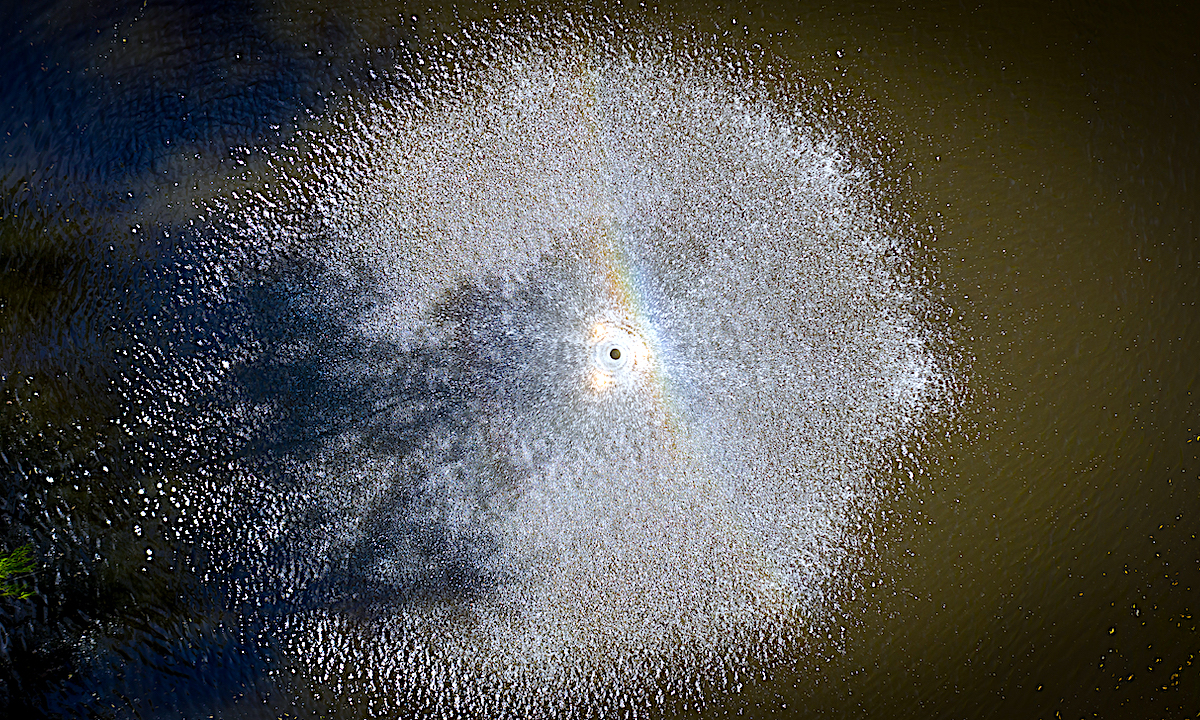Pond aeration systems are a great way to help prevent low oxygen events as well as add to the aesthetics of your lake or pond. In this article, we help you decide which system is right for your pond management goals and maintenance program.
Supplemental Pond or Lake Aeration
Supplemental aeration systems can be an excellent option for your fishery, whether you are looking for a sort of "insurance policy" during low oxygen events or just trying to add a decorative effect.
Here at Pond King, we work with four different types of aeration systems:
- Bottom Diffusers
- Surface Aerators
- Aerating Fountains
- Decorative Fountains
Each type of aeration system has its benefits and specific purpose, but they all have one thing in common: neglecting proper maintenance will significantly shorten the respective system's lifespan.
We typically recommend systems that run off of direct electricity, but solar and wind alternatives may be the only option for your situation. The main drawback to these systems is that they are highly dependent on mother nature, which means you could lose your insurance when you need it the most.
Bottom Diffusers - The Oxygen Workhorse
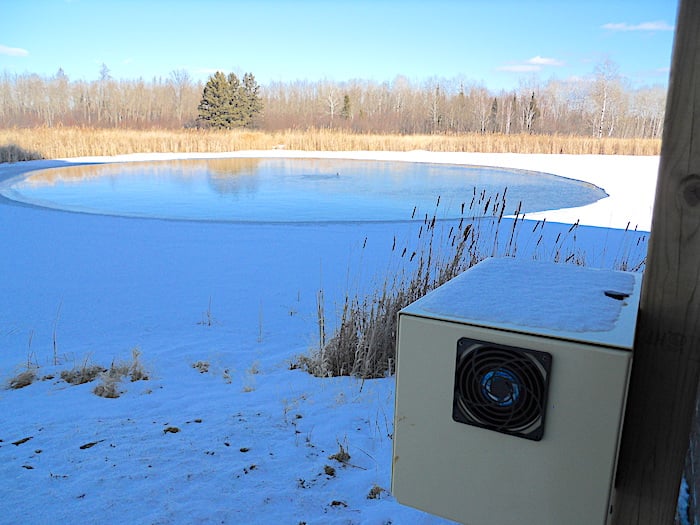
Let's start our review with Bottom Diffusers.
The primary function of these systems in summer is to prevent the pond from stratifying into layers of hot, oxygenated water and cold, un-oxygenated water. In the winter, a bottom diffuser will protect from total lake freezing and provide consistent water temps throughout.
How Does a Bottom Diffuser Pond Aerator Work?
The diffuser utilizes an air compressor to pump pressurized air down to the diffusers that sit on the floor of your pond or lake. The diffusers then create tiny air bubbles that rise to the surface. On their way to the surface, they perform two pond management tasks; allowing more oxygen to be dissolved in the water and creating an upwelling effect.
The smaller the bubble these diffusers can produce, the more effective the system will be at both tasks. A higher density of tiny air bubbles creates a larger surface area for the water to come in contact with. The more surface area the water comes in contact with, the greater the amount of oxygen absorbed into the water through diffusion.
This increased surface area also occupies a larger portion of the column of water it pushes on its way to the surface. The more water the diffuser moves, the greater the effects upwelling will have in eliminating pond stratification.
It is essential to have adequate pond depth when installing these systems. Water movement caused by the upwelling effect can stir up sediments in shallow portions of the pond, creating a turbid fishery.
Depending on your pond's bottom composition, we typically don't recommend bottom diffusers for ponds less than 10-12' of depth.
Bottom Diffuser Maintenance
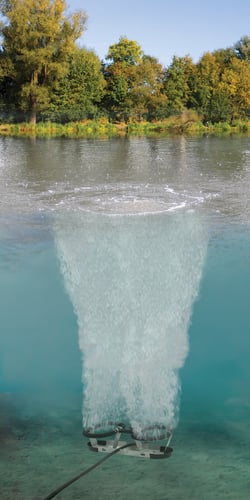
Maintenance of a bottom diffuser system varies in its intensity depending on its installation, location, and utilization.
The compressors used are usually air-cooled. To keep the bottom diffuser functioning properly, it needs adequate fresh air drawn across the unit. If installed in a small area without sufficient fresh airflow, the pump will overheat and need to be replaced over a shorter period of time.
Likewise, the seals and piston rings that create pressure within the pump will also need to be replaced over time, depending on the intensity of utilization. Luckily, most manufacturers offer a rebuild kit with the necessary parts and instructions to make the repairs yourself.
Aerator Maintenance After Periods of Non Use
Additionally, if the system has been out of operation for an extended period, then there is the potential that silt has covered the diffusers. Since the diffusers sit on the pond floor, they are prone to get covered with sediment, preventing the system from functioning properly.
Sometimes all you'll need to do is adjust the manifolds to direct all air pressure to one diffuser, alternating the open valve until all diffusers are working again. Other times, you may need to pull the diffuser up from the bottom of the pond and cleaning it off.
If the system has been off for an extended period, it is imperative not to turn all diffusers back on at once; this can cause a turnover event and a potential fish kill. Instead, turn one diffuser back on, then wait 2-3 weeks to turn another one on, repeat this process until the entire system is back up and running.
Surface Aeration Systems - a Choice between Form and Function
The following three systems are comparable in their makeup and have similar maintenance requirements, so we will discuss each unit and then go over their required maintenance.
Surface Aerators

The first type of system we'll discuss in the surface category is the Surface Aerator.
Surface Aerators units are strictly business when it comes to adding extra oxygen to your pond or lake. These units are industrial in their makeup, floating on the pond's surface while churning and turning over as much water as possible. They are designed to move the maximum amount of water possible as violently as they can. This action disrupts the surface of the water, exposing more water to the air above the surface and trapping air beneath the surface.
The combined effects of this action maximize the amount of water exposed and able to absorb oxygen. These units are by far the most effective way to ensure your fishery always has the most dissolved oxygen available.
These units also benefit your pond in circulating the top layer of water. The suction created from the operation of the pump pulls water from approximately 4' below the surface. This pull, coupled with the dispersion (pushing) effects of the water expelled from the aerator, circulates this top layer of water around, evenly dispersing the increased oxygen levels.
Proper Placement Location for Surface Aerators
Because of the suction created by this unit, we recommended placing it in areas with depths greater than 5'. Keeping the Surface Aerator in water deeper than 5' will limit the amount of sediment disruption that can cause turbidity issues and reduce the amount of debris pulled up against the protection screen.
Aerating Fountains
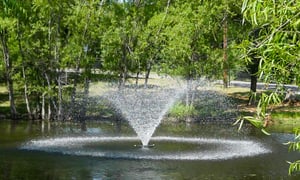
Going from an industrial-type unit to one with a more decorative effect while still having a practical application is the Aerating Fountain.
The one we most typically install is a fountain that produces a simple "V" shaped pattern. This unit doesn't move quite as much water as the surface aerator but still stimulates adequate circulation and provides enough additional oxygen to allow your fishery to make it through some tough situations.
The Aerating Fountain is by far the most popular fountain we offer because of its dual purpose.
Benefits of Aerating Fountains for Ponds
First, it provides a decorative aspect to ponds that may be in direct sight of the house or cabin.
Second, the fountain helps add extra oxygen to the water by producing a thin flow of water that, depending on the size of the motor, can reach 4-8' above the surface of the water.
This pattern increases the overall surface area of water exposed to the air, allowing it to absorb more oxygen. In addition, the water crashing down on the surface helps provide some surface disruption and additional oxygen transfer.
These fountains can also be equipped with led lights that either have colored lenses or can be programmed to change color depending on the model you choose.
Decorative Fountains
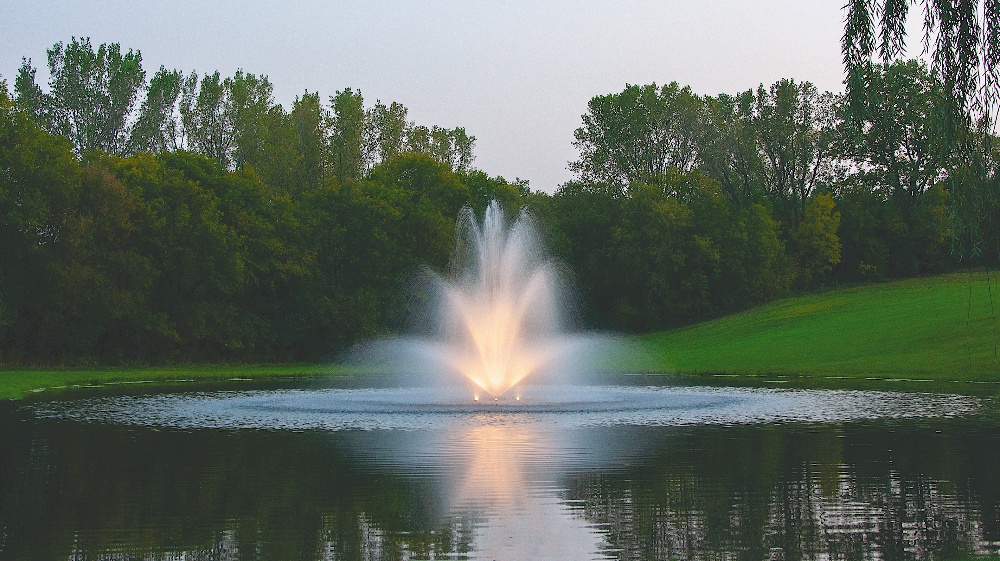
The final option of the fountain systems listed also has the least practical application and focuses primarily on the decorative aspect.
These units come in a wide array of different displays and effects. The thick streams created to produce the displays limit the surface area available for oxygen absorption and limit the amount of water circulated by these systems compared to units of similar size. When the large quantity of water moved through the unit crashes down on the surface, some additional oxygen is added to the pond.
Downsides of Decorative Fountains for Ponds
However, this increase in dissolved oxygen is localized closely around the fountain itself. Decorative fountains are primarily used as displays in front of businesses and in Homeowner Association ponds whose primary goals aren't focused on fish production.
Again, lights are frequently added to these units to add more elements to the visual effects - like a mini Bellagio-style water show in your backyard.
Surface Aerator System Maintenance
As stated earlier, the maintenance on these three units is very similar. Many of these systems have motors mounted directly beneath the floats, with a filter screen to help prevent debris from becoming dislodged in the unit.
The motor mounted directly in the water helps prevent it from overheating but does pose other issues if not properly cared for.
How Do Surface Aerators Work?
With surface aerators, the propeller that moves the water is exposed from the top of the unit. This design can lead to unwanted pests and debris falling in and fouling the motor, which can cause it to overheat and need replacement. If these units have been out of use for an extended period, it is wise to check for any foreign material in the propeller before turning them back on.
General Pond Aerator Maintenance Recommendations
All three of these units have a filter screen underneath to protect the motor. These units are close to the water's surface and often have some filamentous algae growth that occurs. If not cleaned regularly, this algae growth can limit the amount of water available to the propellers and cause the unit to surge or produce a weakened display.
If this happens, a stiff nylon brush easily removes the unwanted vegetation, and the unit should operate normally again.
With all of the electrical supply running directly in the water, all breakers need to be tested regularly to ensure that power will immediately cut off if a short ever does occur.
In instances of light freezing or more temperate winters, the fountains can be run in normal operation. For heavier freezing events, surface aerators should be run 24/7 to maintain an open area in the pond and keep the transfer of oxygen flowing, for the aerating fountains and decorative fountains it is best to shut these units off to prevent ice from building up on the nozzles and burning up the motor.
Finally, if you have one of these units in a pond that freezes for extended periods, removing the unit from the pond is best. Removing the unit will give you time to clean it while also preventing any damage from water freezing within it.
Trust Pond King for All Your Pond Aeration Needs
As you can see, there is a wide variety of options to choose from when it comes to supplemental aeration for your pond. Each unit has its own set of benefits and drawbacks. Make sure the benefits match your goals and that you can live with the drawbacks.
If you have any questions about supplemental aeration or help choosing which unit would be best for your pond, feel free to call or contact us any time!
We'll see y'all down at the pond.


